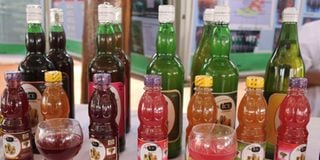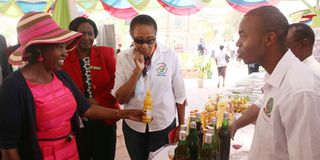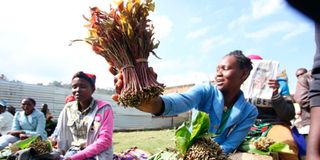How regulator turned khat wine maker’s dream into a nightmare

Samples of wine and juices manufactured from khat (miraa) plant.
What you need to know:
- The product whose manufacturer expected to excite the market is yet to get necessary approvals.
- Mr Kevin Nthiga has spent a tidy sum of money on advancing his invention.
In 2015 when Kevin Nthiga discovered he would make wine and juice using extracts from miraa khat, he was over the moon.
His invention was hailed as a game-changer with industry players saying it would provide a variety of products readily acceptable by a cross-section of consumers, and lead to good business.
Mr Nthiga, then a final year student at Jomo Kenyatta University of Agriculture and Technology (JKUAT) studying food science, got interviews with various media outlets after he showcased his products at national trade fair and enjoyed his minutes of fame. But that was the farthest it went.
Six years down the line and now a Masters graduate in the same field, a product he expected would excite the market within a couple of months and find space in supermarket shelves, is yet to get necessary approvals.

Kevin Nthiga, then a final year student at Jomo Kenyatta University of Agriculture and Technology (JKUAT), displays samples of khat juice and wine to Deputy President William Ruto's wife Rachael Ruto.
“I have been up and down seeking authorisation from government agencies but Kebs (Kenya Bureau of Standards) cannot even accept my samples for analysis,” the Thika-based inventor said in an interview.
So far, Mr Nthiga has spent a tidy sum of money on advancing his invention.
The reason Kebs cannot touch his samples is that the National Authority for the Campaign Against Alcohol and Drug Abuse (Nacada) says miraa is a drug and has placed it in the same category with cocaine and other hard drugs.
Hard drugs
This has baffled sector players who wonder why miraa is lumped with hard drugs, yet it is a crop recognised by the government and is funded by the same.
Miraa is estimated to be worth over Sh40 billion annually with prospects of higher returns with value addition products such as wine, juice, miraa flavoured tea and chewing gum, according to Nyambene Miraa Traders Association (Nyamita) chairman Kimathi Munjuri.
“The confusion where one government agency recognises miraa as a crop and the other says it is a drug is what we cannot understand. Does this mean the government is funding production of a drug?” posed Mr Munjuri.
He said with public sensitisation materials out there in Nacada website showing the stimulant was a hard drug, it was difficult to market the produce in the international markets and extract value addition products from the twigs.

Women sell miraa in Maua town, Igembe South.
“We have tried to lobby removal of this offensive information but Nacada has gone mute. In February last year we met officials who promised to remove them but this has not happened. We wrote a letter last month but we have not received any response, not even acknowledgement that it was received,” he added.
However, Nacada maintains that miraa contains harmful substances and so long as the law is not changed, the agency would continue advising the public against its use.
Mr Victor Okioma, Nacada chief executive officer, said the agency’s position was backed by research that identified harmful substances in miraa, adding that this position would only be changed by further research and amendment of necessary pieces of legislation.
Harmful substances
“Our position is that we campaign against drugs abuse and with Kenya being a member of the Commission on Narcotics and Drugs which follows World Health Organisation guidelines on harmful substances around the world, we are bound by those laws,” Mr Okioma told Smart Business in a phone interview.
“We know that miraa is a crop recognised by the government and a source of livelihood for farmers and traders in some parts of the country but that does not change the fact that there are disorders associated with its consumption especially muguka,” he added.
However, there is a ray of hope after Kebs started developing standards for the crop.
Recently, the agency held an online stakeholder sensitisation workshop during which it presented draft regulations that if adopted would be used as a basis to market the produce.
According to the draft, the standards of procedures of practice include ensuring hygiene is observed in the entire chain from harvesting to packaging and loading into vehicles and aircrafts.
Kebs says the Kenya Code of Practice for the Miraa (Khat) Industry has been developed by the national workshop on Miraa under the guidance of the Standards Projects Committee.
“This code stipulates the hygienic and safety requirements during the production, handling and marketing of miraa. The standard also considers the safety provisions for consumers and workers in the industry,” the agency says.





